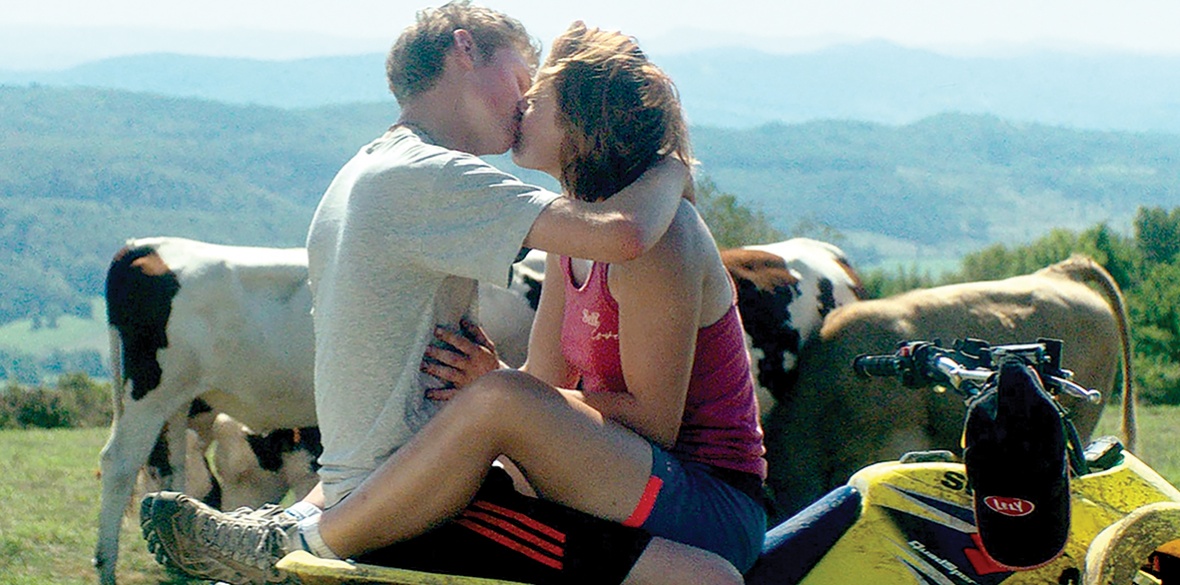This is the last article you can read this month
You can read more article this month
You can read more articles this month
Sorry your limit is up for this month
Reset on:
Please help support the Morning Star by subscribing here
Holy Cow (15)
Directed by Louise Courvoisier
★★★★
SHOT in France’s Jura region with non-professional actors, Louise Courvoisier’s debut feature is touching, elegiac and funny. A coming-of-age drama about friendship, integrity and post-industrial agriculture, it also reveals the agonies of making a wheel of Comté cheese.
A splendidly chaotic opening scene sets the tone. It features a cow sitting in a car, a man in a ragged vest lugging a beer barrel through a rural gala, and a drunken 18-year-old, Totone, performing a naked jig on a tabletop.
When Totone’s hedonism is curtailed by a tragedy that makes him the sole carer to Claire, his seven-year-old sister, he sees salvation in a €30,000 Comté cheese contest. His plans are jeopardised by relationships with boozy friends and thuggish enemies. Then there are his burgeoning feelings for the tough, witty and compassionate Marie-Lise.
There are inspired performances from the film’s young leads. Clement Favea (Totone) and Luna Garret (Claire) convey shifts in emotion through dialogue, gaze and expression. Maiwene Barthelemy (Marie-Lise) is a revelation. A pivotal scene in which her voice and features tremble with barely controlled rage could have been overplayed and reduced to cliche. The fact that it’s perfectly pitched is a credit to both actor and director.
Crisp dialogue is augmented with painterly images of landscape, weather, machinery and people. The story arc – from ambition to disappointment to achievement – is familiar but subverted by a subtle and complex resolution. An auspicious debut, Holy Cow is an optimistic but unflinchingly honest portrait of rural life and industry.
Andy Hedgecock
In cinemas from tomorrow.
One to One: John and Yoko (15)
Directed by Kevin Macdonald and Sam Rice-Edwards
★★★
IT WOULDN’T be a surprise if readers of this review say, “please – not another film about John Lennon.” However, this is no piece of hagiography. Rather, it’s a collage of predominantly found footage detailing the only full concert that Lennon played post-Beatles, and the political ferment in which he immersed himself after he and Yoko Ono moved to New York City in 1971.
Kevin McDonald and Sam Rice-Edwards use new footage of the couple’s loft in Greenwich Village (shown as it might have looked in 1971) interspersed with concert footage, TV adverts, and myriad political and cultural images: Attica; Vietnam; Nixon; George Wallace; Kathleen Cleaver; Watergate; the Yippies; a Billy Graham rally; and many others.
The conceit is to present what John and Yoko would have seen when watching TV, which they spent a lot of time doing; sometimes, as in the discussion of the Willowbrook mental facility for children, for which the benefit concert was played, by showing us the documentary footage, then cutting and zooming out to it playing on the TV in their apartment.
Stenograph-style intertitles are used to represent the content of phone conversations between Yoko/John and various assistants. These have the effect of slowing down the action, as the rest of the cutting is often very quick, as was typical of the period.
These sections represent the couple thinking politically rather than acting politically, providing an in-film commentary on the world in which they moved.
Sound provides a bridge between what’s in Lennon’s head and the world outside. Sometimes it’s in counterpoint, so Come Together is mixed with footage of George Wallace the Alabama governor, a segregationist and racist and wannabe Democrat candidate for the 1972 presidential election; Hound Dog, with “Tricky Dicky” Richard Nixon out campaigning.
We see John and Yoko with many of the radical figures of the era: Jerry Rubin; John Sinclair; Allen Ginsberg; Abbie Hoffman, and others. Indeed, the uninitiated might require a search engine open to understand fully just what a turbulent political environment the US of 1971 was.
The music is marvellous. The film? Very much worth a watch, especially given its focus on the anti-war movement, a parallel with our time.
Martin Hall
In cinemas from tomorrow.
King of Kings (PG-13)
Directed by Seong-Ho Jang
★★
A PREDICTABLE Easter memento to Christian kids the world over of the bio of Jesus of Nazareth, the founder of their faith.
This digitally generated, clunky animation centres around Charles Dickens retelling his son Walter, and their cat, “the greatest story ever told.”
The action is tele-transported between the living room of the Dickens residence and Galilee — all the miracles are diligently accounted for and treachery, political shenanigans, torture and gruesome execution complete the picture.
All to good effect apparently as we see the initially sceptical Walter become entranced.
Job done — as far as we can tell — for Utah-based producers Angel Guild. You’d think, but not as after the voice credits, which include Kenneth Branagh, Uma Thurman, Ben Kingsley, Forest Whitaker and Pierce Brosnan, had rolled comes a “message” delivered by a line of white only kids who, one by one, extol the virtues of the film and prompt others to view it most urgently.
A thought occurs that the Nazarene might actually not entirely concur.
Michal Boncza
In cinemas from tomorrow.
Panda Bear in Africa (6+)
Directed by Richard Claus and Karsten Kiilerich
★★
ATTEMPTING to cross The Jungle Book with The Lion King and Kung Fu Panda, this Dutch/Danish/German/French/Estonian euro-pudding for kids serves up a cultural mayonnaise that manages to be both neo-colonial and suburban at the same time.
The daft premiss is that interspecies friendships should trump tribal loyalty, and different types of kid — fat, talkative, reticent and playful — are their own animal, be it panda, monkey, dragon or lion. The magical powers belong to the only female character in what is otherwise an exclusively male playground romp.
The overall effect is weirdly retro, like finding yourself in an animated jungle in the 1970s where the creatures read maps and ply surprising trade routes from China to South Africa. Is this Brics for kids, one wonders, as the underlying sexism and racism is smoothed away beneath an efficient veneer of Disney-style cute faces and caricatures.
Indigestible.
Angus Reid
On digital platforms.










